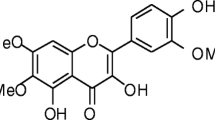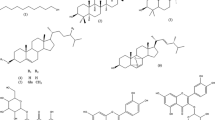Abstract
In the present study we assessed the neuroprotective role of aHypericum perforatum ethanolic extract and obtained fractions in amyloid-β peptide (Aβ)(25–35)-induced cell death in rat cultured hippocampal neurons. Lipid peroxidation was used as a marker of oxidative stress by following the formation of TBARS in rat cortical synaptosomes, after incubation with ascorbate/Fe2+, alone or in the presence of EC97 effective concentrations ofH. perforatum fractions. Induced lipid peroxidation was significantly inhibited by fractions containing flavonol glycosides, flavonol and biflavone aglycones, and by a fraction containing several phenols, mainly chlorogenic acid-type phenolics (21%,77%and 98%, respectively). Lipid peroxidation evaluated after incubation with 25 μM Aβ(25–35), was significantly inhibited byH. perforatum extract.
Cell viability was assessed by use of the Syto-13/PI assay. The total ethanolic extract (TE) and fractions containing flavonol glycosides, flavonol and biflavone aglycones, reduced Aβ(25–35)-induced cell death (65%,58%and 59%,respectively). These results were further supported by morphological analysis of cells stained with cresyl violet. Peptide β-amyloid(25–35) induced a decrease in cell volume, chromatin condensation and nuclear fragmentation, alterations not evident in the presence of the TE and fractions containing hypericins (hypericin concentration = 11.02 μM), or fractions containing flavonoids (quercetin concentration = 21.13 μM). Dendritic lesion,an evidence of neurodegeneration, was observed by neuronal staining with cobalt following insult with Aβ(25–35), but prevented after exposure to the peptide plus the fractions referred above.
The results of the present paper suggest thatH. perforatum extracts may be endowed with neuroprotective compounds able to prevent Aβ(25–35)-induced toxicity.
Similar content being viewed by others
References
Agostinho P and CR Oliveira (2003) Involvement of calcineurin in the neurotoxic effects induced by amyloid-beta and prion pep-tides.Eur. J. Neurosci. 17, 1189–1196.
Ahlemeyer B and J Krieglstein (2003) Neuroprotective effects of Ginkgo biloba extract.Cell. Mol. Life Sci. 60, 1779–1792.
Alvarez G, M Ramos, F Ruiz, J Satrustegui and E Bogonez (2003) Pyruvate protection against beta-amyloid-induced neuronal death: role of mitochondrial redox state.J. Neurosci. Res. 73, 260–269.
Ambrósio AF, AP Silva, JO Malva, JF Mesquita, AP Carvalho and CM Carvalho (2000) Role of desensitization of AMPA receptors on the neuronal viability and on the [Ca2+]i changes in cultured rat hippocampal neurons.Eur. J. Neurosci. 12, 2021–2031.
Areias FM, AC Rego, CR Oliveira and RM Seabra (2001) Antioxidant effect of flavonoids after ascorbate/Fe(2+)-induced oxidative stress in cultured retinal cells.Biochem. Pharmacol. 62, 111–118.
Bains JS and CA Shaw (1997) Neurodegenerative disorders in humans: the role of glutathione in oxidative stress-mediated neu-ronal death.Brain Res. Rev. 25, 335–358.
Bastianetto S and R Quirion (2002) Natural extracts as possible protective agents of brain aging.Neurobiol. Aging 23, 891–897.
Behl C and B Moosmann (2002) Antioxidation neuroprotection in Alzheimer’s disease as preventive and therapeutic approach.Free Radic. Biol. Med. 33, 182–191.
Brewer GJ, JR Torricelli, EK Evege and PJ Price (1993) Optimized survival of hippocampal neurons in B27-supplemented Neurobasal, a new serum-free medium combination.J. Neurosci. Res. 25, 567–576.
Butterweck V (2003) Mechanisms of action of St John’s wort in depression.CNS Drugs 17, 539–562.
Cakir A, A Mavi, A Yildirim, ME Duru, M Harmandar and C Kazaz (2003) Isolation and characterization of antioxidant phenolic compounds from the aerial parts of Hypericum hyssopifolium L. by activity-guided fractionation.J. Ethnopharmacol. 87, 73–83.
Casley CS, JM Land, MA Sharpe, JB Clark, MR Duchen and L Canevari (2002) Beta-amyloid fragment 25–35 causes mitochon-drial dysfunction in primary cortical neurons.Neurobiol. Dis. 10, 258–267.
Conforti F, GA Statti, R Tundis, F Menichini and P Houghton (2002) Antioxidant activity of methanolic extract of Hypericum triquetrifolium Turra aerial part.Fitoterapia 73, 479–483.
Cotman CW and JH Su (1996) Mechanisms of neuronal death in Alzheimer’s disease. Brain Pathol.6, 493–506.
Di Carlo G, F Borrelli, E Ernst and AA Izzo (2001) St John’s wort: prozac from the plant kingdom.Trends Pharmacol. Sci. 22, 292–297.
Dias ACP, RM Seabra, PB Andrade, F Ferreres and MF Ferreira (1999) The development and evaluation of a HPLC-DAD method for the analysis of the phenolic fractions fromin vivo andin vitro biomass of Hypericum species.J. Liquid Chromatography & R.T. 22, 215–217.
Du HY, M Olivo, BK Tan and BH Bay (2003) Hypericin-mediated photodynamic therapy induces lipid peroxidation and necrosis in nasopharyngeal cancer.Int. J. Oncol. 23, 1401–1405.
Erdelmeier CAJ, E Koch and R Hoerr (2000)Hypericum perfora-tum — St. John’s wort chemical, pharmacological and clinical aspects, In: Atta-ur-Rahman (Ed.)Studies in Natural Products Chemistry — Bioactive Natural Products (Part C) (Elsevier Direct: New York), Vol. 22, pp. 643–716.
Greeson JM, B Sanford and DA Monti St, (2001) St. John’s wort (Hypericum perforatum): a review of the current pharmacological, toxicological, and clinical literature.Psychopharmacology 153, 402–414.
Hensley K, JM Carney, MP Mattson, M Aksenova, M Harris, JF Wu, RA Floyd and DA Butterfield (1994) A model for ß-amyloid aggregation and neurotoxicity based on free radical generation by the peptide: relevance to Alzheimer disease.Proc. Natl. Acad. Sci. USA 94, 3270–3274.
Hunt EJ, CE Lester, EA Lester and RL Tackett (2002) Effect of St. John’s wort on free radical production.Life Sci. 69, 181–190.
Jellinger KA (2001) Cell death mechanisms in neurodegeneration.J. Cell. Mol. Med. 5, 1–17.
Malva JO, AP Vieira and CR Oliveira (2003) Understanding physiology of glutamate receptors by use of a protocol for neuronal staining.Adv. Physiol. Edu. 27, 78–85.
Mattson MP (1997) Central role of oxyradicals in the mechanism of amyloid ß-peptide cytotoxicity.Alzheimer Dis. Rev. 2, 1–14.
Mattson MP, J Partin and JG Begley (1998) Amyloid ß-peptide induced apoptosis-related events in synapses and dendrites.Brain Res. 807, 167–176.
Melo JB, P Agostinho and CR Oliveira (2002) Amyloid ß-peptide 25-35 reduces [3H]acetylcholine release in retinal neurons. Involvement of metabolic dysfunction.Amyloid 9, 221–228.
Mook-Jung I, H Kim, W Fan, Y Tezuka, S Kadota, H Nishijo and MW Jung (2002) Neuroprotective effects of constituents of the oriental crude drugs, Rhodiola sacra, R. sachalimensis and Tokaku-joki-to against ß-amyloid toxicity, oxidative stress and apoptosis.Biochem. Pharmacol. Bull. 25, 1101–1104.
Moreira PI, MS Santos, A Moreno and CR Oliveira (2001) Amyloid ß-peptide promotes permeability transition pore in brain mitochondria.Biosci. Rep. 21, 789–800.
Moreira PI, MS Santos, AM Moreno and R Seica and CR Oliveira (2003) Increased vulnerability of brain mitochondria in diabetic (Goto-Kakizaki) rats with aging and amyloid-ß exposure.Diabetes 52, 1449–1556.
Morimoto K and T Oda (2003) Kainate exacerbates ß-amyloid tox-icity in rat hippocampus.Neurosci. Lett. 340, 242–244.
Muller WE, A Singer, M Wonnemann, U Hafner, M Rolliand and C Schafer (1998) Hyperforin represents the neurotransmitter reup-take inhibiting constituent of hypericum extract.Pharmacopsychiatry 31 (Suppl 1): S16-S21.
Nahrstedt A and V Butterweck (1997) Biologically active and other chemical constituents of the herb ofHypericum perforatum L.Pharmacopshychiatry 30, 129–134.
Pereira C, MS Santos and CR Oliveira (1999) Involvement of oxidative stress on the impairment of energy metabolism induced by A beta peptides on PC12 cells: protection by antioxidants.Neurobiol. Dis. 6, 209–219.
Pereira CF, P Moreira, R Seica, MS Santos and CR Oliveira (2000) Susceptibility to beta-amyloid-induced toxicity is decreased in goto-kakizaki diabetic rats: involvement of oxidative stress.Exp. Neurol. 161, 383–391.
Prior RL (2003) Fruits and vegetables in the prevention of cellular oxidative damage.Am. J. Clin. Nutr. 78 (3 Suppl): 570S-578S.
Raina AK, A Hochman, X Zhu, CA Rottkamp, A Nunomura, SL Siedlak, H Boux, RJ Castellani, G Perry and MA Smith (2001) Abortive apoptosis in Alzheimer’s disease.Acta Neuropathol. (Berl.) 101, 305–310.
Rego AC, N Monteiro, AP Silva, JO Malva and RO Catarina (2003) Mitochondrial apoptotic cell death and moderate superoxide generation upon selective activation of non-desensitizing AMPA receptors in hippocampal cultures.J. Neurochem. 86, 792–804.
Schempp CM, V Kirkin, B Simon-Haarhaus, A Kersten, J Kiss, CC Termeer, B Gilb, T Kaufmann, C Borner, JP Sleeman and JC Simon (2002) Inhibition of tumour cell growth by hyperforin, a novel anticancer drug from St. John’s wort that acts by induction of apoptosis.Oncogene 21, 1242–1250.
Silva AP, AP Carvalho, CM Carvalho and JO Malva (2001) Modulation of intracellular calcium changes and glutamate release by neuropeptide Y1 and Y2 receptors in the rat hippocampus: differential effects in CA1, CA3 and dentate gyrus.J. Neurochem. 79, 286–296.
Silva BC and ACP Dias (2002) Evaluation of the free radical scavenger activity ofHypericum perforatum alcoholic extracts.Revista de Fitoterapia 2 (Suppl. 1): p. 133.
Small DH and CA McLean (1999) Alzheimer’s disease and the amyloid ß-protein: what is the role of amyloid?J. Neurochem. 73, 443–449.
Tomiyama T, A Shoji, K Kataoka, Y Suwa, S Asano, H Kaneko and N Endo (1996) Inhibition of amyloid ß-protein aggregation and neurotoxicity by rifampicin.J. Biol. Chem. 12, 6839–6844.
Valentäo P, E Fernandes, F Carvalho, PB Andrade, RM Seabra and ML Bastos (2002) Antioxidant activity of Hypericum androsae-mum infusion: scavenging activity against superoxide radical, hydroxyl radical and hypochlorous acid.Biol. Pharm. Bull. 25, 1320–1323.
Vila M and S Przedborski (2003) Targeting programmed cell death in neurodegenerative diseases.Nat. Rev. Neurosci. 4, 365–375.
Ward MW, AC Rego, BG Frenguelli and DG Nicholls (2000) Mitochondrial membrane potential and glutamate excitotoxicity in cultured cerebellar granule cells.J. Neurosci. 20, 7208–7219.
Yankner B (1996) Mechanisms of neuronal degeneration in Alzheimer’s disease.Neuron 16, 921–932.
Youdim KA and JA Joseph (2001) A possible emerging role of phy-tochemicals in improving age-related neurological dysfunctions: a multiplicity of effects.Free Radic. Biol. Med. 30, 583–594.
Youdim KA, JP Spencer, H Schroeter and C Rice-Evans (2002) Dietary flavonoids as potential neuroprotectants.Biol. Chem. 383, 503–519.
Author information
Authors and Affiliations
Corresponding author
Rights and permissions
About this article
Cite this article
Silva, B.A., Dias, A.C.P., Ferreres, F. et al. Neuroprotective effect ofH. perforatum extracts on β-amyloid-induced neurotoxicity. neurotox res 6, 119–130 (2004). https://doi.org/10.1007/BF03033214
Received:
Revised:
Issue Date:
DOI: https://doi.org/10.1007/BF03033214




